Wind Dynamics and Kiteboarding Insights in San Diego
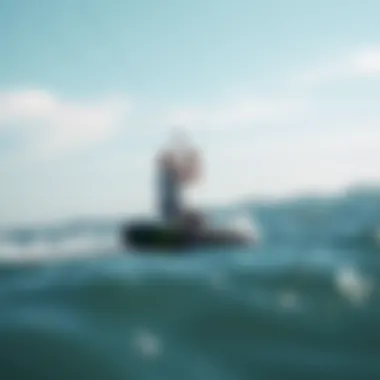
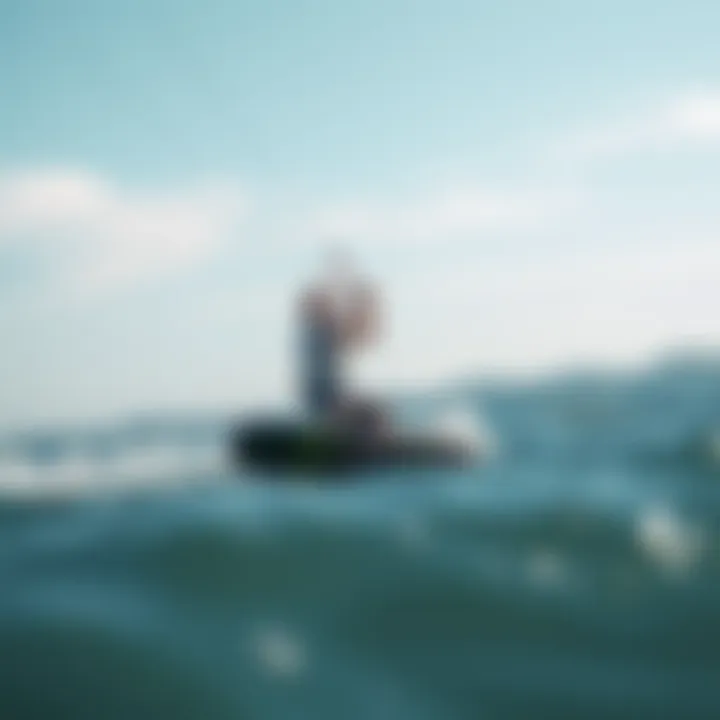
Intro
When it comes to kiteboarding in San Diego, the wind is more than just a helpful companion; it’s the lifeblood of the sport. For kiteboarders—both seasoned veterans and those just dipping their toes into the turquoise waters—understanding the local wind dynamics can make or break your outing. Picture this: you’ve packed your gear and arrived at the beach, but if the wind isn’t cooperating, you could end up watching from the shore instead of riding the waves.
The significance of mastering wind patterns extends beyond mere enjoyment; it plays a crucial role in safety measures and personal skill development. Armed with the knowledge of how wind direction and speed impact your kiteboarding experience, you can fine-tune your technique and maximize your time on the water. This guide aims to shed light on these wind dynamics, emphasize key seasonal variations, and provide actionable tips for any kiteboarding aficionado keen on improving their craft.
Understanding the subtleties of wind patterns in San Diego is like having a secret map that leads to the best spots for kiteboarding. With the oft-blustery coastal winds and changing weather conditions, you’ll find that digging deeper into this topic is not just beneficial—it's essential.
Gear and Equipment
Equipping yourself with the right gear is foundational in kiteboarding, especially when contending with varying wind dynamics. Choosing appropriate gear tailored to your skill level and the wind conditions is paramount.
Essential Kiteboarding Gear for Beginners
For those just getting started, the world of kiteboarding can be overwhelming. However, having the right equipment does wonders in making the experience enjoyable and safe. Here’s what you need:
- Kite: A size-appropriate kite is crucial. If you're a beginner, go for a kite with a larger size for better lift in lighter winds. Something around 9-12 meters typically works well.
- Board: A wider board gives more stability and buoyancy in water. Look for boards labeled for beginner use.
- Control Bar: This is your connection to the kite, making it vital that it is well balanced and comfortable for your grip.
- Harness: A waist harness is a common choice, distributing the forces exerted by the kite evenly across your body.
- Safety Gear: Helmets and impact vests can’t be overstated—these keep you protected during your learning phase.
Advanced Equipment for Experienced Riders
As you grow more comfortable and adept, your gear needs may also evolve:
- Kite Models: Riders should experiment with different kite models—C-shaped for tricks or delta-shaped for general use, depending on the wind conditions and style.
- Foil Boards: These are perfect for cutting through chop on windy days, giving you a unique experience.
- Additional Safety Gear: Upgraded harnesses or specialized helmets can offer added protection during high-speed maneuvers.
Understanding the right equipment is really about knowing what fits your level and the wind behavior you’ll encounter.
"Good wind knowledge is like a seasoned sailor knowing how to ride the waves; it gives you an edge in mastering your craft."
Techniques and Tips
Learning how to ride the wind effectively can boost both your confidence and enjoyment of kiteboarding. Here are some techniques and tips worth considering:
Safety Practices for Kiteboarding
Safety should be your number one priority on the water. Knowing how to read wind conditions can prevent accidents. Here are some safety practices:
- Check Wind Reports: Resources like Windy and local forecasting sites can be lifesavers.
- Buddy System: Always kite with a friend; they can help should you encounter trouble.
- Know Your Limits: If the winds are too fierce, don’t hesitate to wait until they become more manageable.
Training Techniques to Improve Your Skills
- Kite Control Training: Spend time on the beach practicing control with your kite before hitting the water. This builds confidence and control.
- Progressive Learning: Start with simple maneuvers and gradually work your way to more complex tricks as your skill set expands.
- Feedback Mechanism: Consider getting tips from more experienced kiteboarders or instructors; they can offer invaluable insights into your technique.
By diving into the nitty-gritty of wind dynamics and proper gear, novices and experts alike can make the most of their kiteboarding adventures in San Diego. Stay tuned as we further unravel the relationship between kiteboarding and the winds that propel it.
Prelims to Wind in San Diego
When it comes to kiteboarding in San Diego, understanding the wind is not just a good idea; it's essential. In a sport where the wind can make or break your experience, grasping the nuances of local wind patterns can vastly enhance your enjoyment. The interplay between wind speeds, directions, and topography creates a dynamic environment that kiteboarders must navigate. From the thrill of soaring through the air to the pain of crashing into the water, the wind shapes every aspect of a kiteboarder's day on the waves.
Significance of Wind for Kiteboarding
Wind is the lifeblood of kiteboarding. Without it, kiteboarding enthusiasts would be left gazing wistfully at the sea, longing for the pull of a steady breeze. Here's why understanding wind is crucial for kiteboarding:
- Lift and Speed: Adequate wind provides the lift needed for jumps and tricks. Too much wind can also hinder performance, making it difficult to control the kite.
- Safety: Knowing how to assess wind conditions can prevent dangerous situations. High winds can create powerful waves and chop, making a well-informed kiteboarder a safer one.
- Maximizing Enjoyment: Good wind conditions can elevate the experience, enabling you to harness the elements and enjoy the ride fully.
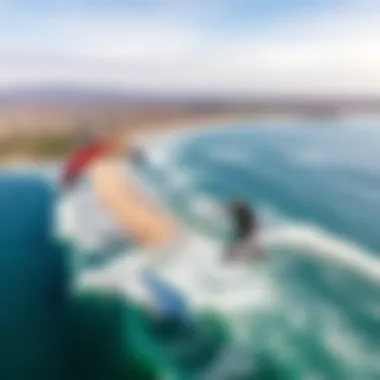
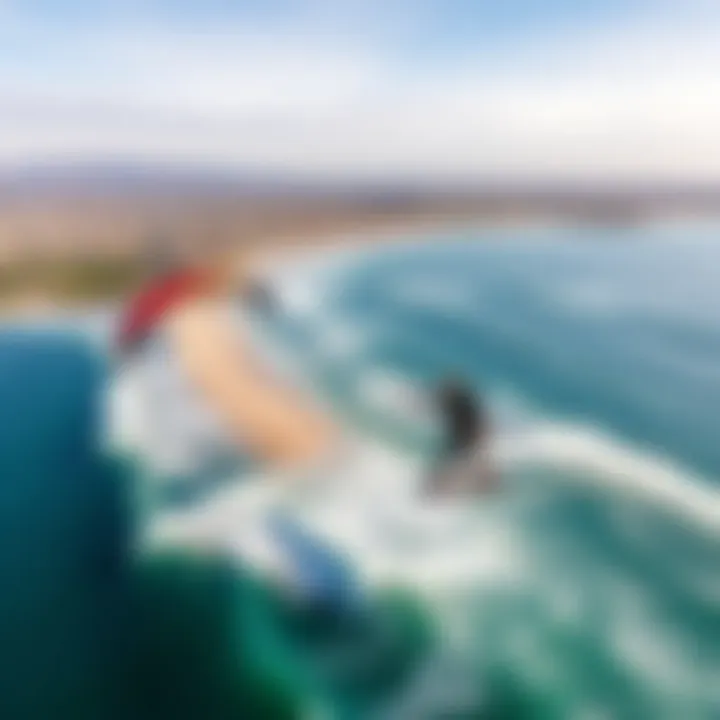
"The wind whispers secrets only to those who listen carefully."
This adage rings particularly true for kiteboarders who pay attention to their surroundings to predict the best times to hit the water.
Overview of San Diego's Geography
San Diego's unique geography plays a pivotal role in its wind patterns. Nestled between mountains and the Pacific Ocean, the city enjoys a range of microclimates that can greatly affect wind behavior. Key geographical features include:
- Coastal Line: The coastline provides consistent ocean breezes, with areas like Mission Bay and La Jolla often becoming wind havens.
- Natural Barriers: The mountains to the east can block wind or funnel it, creating varying conditions across different locations.
- Proximity to the Ocean: Being close to the ocean means that seabreezes can develop, often shifting direction during the day based on temperature fluctuations.
Understanding not only where to go but also why the wind acts the way it does in specific areas can give kiteboarders a significant edge. Familiarity with the local terrain will ultimately make you a better kiteboarder, as you learn to read the wind and respond accordingly.
Understanding Local Wind Patterns
Understanding local wind patterns is essential for kiteboarders in San Diego. Kiteboarding is not just about enjoying the ride; it’s about using the wind as your trusted partner. The dynamics of wind, influenced by geography, topography, and atmospheric conditions, dictate how and when one can successfully harness its power. For both newcomers eager to dip their toes and seasoned kiteboarders looking for the perfect wave, grasping these wind nuances can significantly enhance the experience.
When kiteboarding in San Diego, one must consider several critical elements of wind:
- Wind direction: Determines the best launch spots and the quality of the ride.
- Wind speed: Impacts safety; too strong or too weak can cause challenges.
- Wind consistency: Affects how predictable the ride will be, enabling better planning.
Understanding these factors doesn’t just aid in riding effectively; it allows kiteboarders to feel more in control and connected with their surroundings, making every session not just an exercise but an adventure.
Prevailing Winds and Their Effects
Prevailing winds, those that blow predominantly from one direction, play a pivotal role in setting the stage for kiteboarding in San Diego. The most prominent prevailing wind in the area is the westerly wind, influenced by the Pacific Ocean. This wind tends to kick in around midday, often bringing with it the perfect conditions for kiteboarding.
- Cruising to the Beach: The afternoon winds can reach speeds of 15 to 25 knots. This creates an exhilarating atmosphere for kiteboarding enthusiasts who flock to popular beaches like Mission Bay and La Jolla Shores. The steady breeze makes these spots ideal for both learning and showcasing advanced skills.
- Wind Effects on Performance: Understanding these prevailing winds can enhance performance. For instance, beginners can work on their skills without worrying too much about unexpected changes. On the flip side, experienced kiteboarders can exploit these winds to perform tricks and maneuvers, resulting in electric performances that amaze spectators on the beach.
- Turbulence Awareness: However, there’s a caveat. Near cliffs or buildings, wind can behave unpredictably, resulting in turbulence. Knowing where these areas are allows boarders to strategize their routes while maintaining safety.
Understanding the wind patterns isn't just an added bonus; it’s as critical as choosing the right gear.
Microclimates and Wind Variations
San Diego's geography gives rise to various microclimates, which can cause significant wind variations within short distances. A microclimate can be described as a local atmospheric zone where the climate differs from the surrounding areas. This phenomenon is crucial for kiteboarders because conditions can dramatically shift just a few miles apart.
- How Microclimates Form: Coastal features such as hills, valleys, or urban developments can create subtle yet impactful changes in wind direction and intensity. For instance, the cliffs near Point Loma can lead to stronger winds, while sheltered areas like the bays might see a lull.
- Adapting to Variations: Kiteboarders can harness these variations creatively. By recognizing where to find stronger winds, they can plan specific sessions based on their skill level. Visiting less traveled spots like Silver Strand State Beach, where environmental aspects differ, may yield untraveled opportunities for skilled kiteboarding.
- Wind Shifts: Furthermore, kiteboarders need to be aware that winds change throughout the day. Morning winds may start calm and gentle, prompting a leisurely session. As the sun climbs, these winds often pick up, leading to a more intense experience. Noting the rhythm of wind tendencies can help in scheduling outings effectively.
In summary, comprehending the local wind patterns in San Diego is like decoding a map to an untouched treasure. With such knowledge, kiteboarders can maximize their ride, ensuring that each outing is safe and enjoyable.
Seasonal Wind Trends
Understanding seasonal wind trends is crucial for kiteboarders navigating the waters of San Diego. The wind doesn’t blow the same way all year round; it dances and shifts with the seasons, directly impacting kiteboarding activities. Knowing how wind trends vary can lead to a safer and more enjoyable experience on the water.
Overview of Seasonal Changes
The seasonal variations in wind conditions are a significant force shaping the kiteboarding experience in San Diego. During spring and summer, the winds pick up considerably, making it a prime time for kiteboarders.
- Spring: The transition from winter to spring often sees an unpredictable wind pattern. While some days might offer perfect conditions, others will catch you off guard with sudden shifts. Increased storm activity can lead to swirling wind conditions, so if you’re hitting the waves, keep an eye on local forecasts.
- Summer: Things heat up during summer. The coastline generally experiences the strongest and most consistent winds. The warm air from the inland deserts drives cooler ocean breezes, creating ideal conditions for kiteboarding. The popular season typically runs from June to September, where the northwest winds blow reliably throughout the day.
- Fall: Wind patterns begin to mellow. The strong summer breezes start to fade, yet some remarkable days can still surprise eager kiteboarders. Predicting fall winds becomes trickier, as instability increases with fluctuating temperatures.
- Winter: The winter months can be hit or miss. While some days bring robust squalls, others might leave kiteboarders waiting for a breeze that doesn't come. Cold fronts can sweep down from the north, causing gusty winds. Kiteboarding is still possible, but safety measures should always be top of mind due to unpredictable weather.
Ideal Months for Kiteboarding
If you are serious about kiteboarding in San Diego, knowing the peak months is essential. Here are the best times to grab a kite and head out:
- June through August: This is generally the sweet spot for kiteboarding enthusiasts. Strong, consistent winds make for perfect conditions. Being out on the water becomes a daily ritual for many.
- September: The winds may still hold strong, but the crowds begin to thin out. For those seeking a less busy experience, September can be fantastic.
- October and Early November: Some kiteboarders swear by this period, where the summer's winds linger on the edges, providing intermittent good conditions.
"Timing is everything. The right month can mean the difference between smooth sailing and a day spent battling gusts."
For those keen on other activities or just exploring, the off-peak months can offer an opportunity to appreciate the local coastline without the hustle. Just be prepared for varying conditions, and always check forecasts through reliable resources like NOAA or Wunderground to avoid surprises.
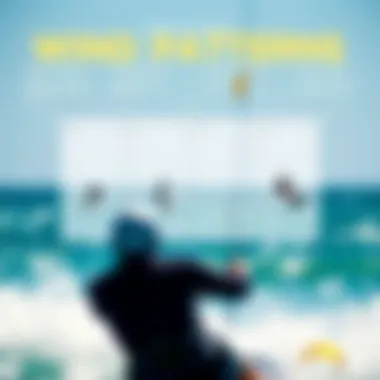
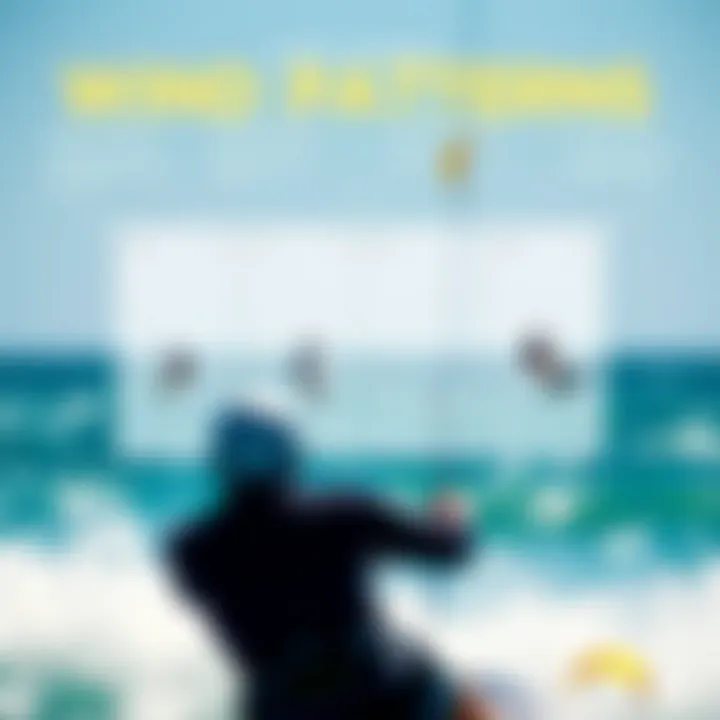
Having a grasp of seasonal wind trends paves the way for enhancing kiteboarding strategies, ensuring both safety and fun on the beautiful waters of San Diego.
Key Locations for Kiteboarding in San Diego
When it comes to kiteboarding, choosing the right spot is half the battle won. San Diego is blessed with a variety of locations that boast excellent wind conditions, each tailored to different skill levels and preferences. But it’s not just about the wind; these locations also come with unique characteristics that enhance the kiteboarding experience.
Best Beaches for Wind Conditions
San Diego's coastline is dotted with several renowned kiteboarding hotspots. Here are some of the best beaches to consider:
- Mission Beach: With long stretches of sand and plenty of open water, Mission Beach is a kiteboarder's playground. The winds here are generally consistent, making it a favored spot, particularly among intermediate to advanced riders.
- La Jolla Shores: Known for its beautiful surroundings, La Jolla Shores offers a bit of everything. The wind conditions can vary but often provide ideal kiteboarding weather. It's also a good spot for beginners, as there are calm areas sheltered from stronger winds.
- Silver Strand State Beach: This beach is perhaps lesser-known among kiteboarders, but it’s a hidden gem with spacious areas where riders can launch and land their kites with ease. Make sure to check the wind forecasts, as conditions here can shift swiftly.
- Coronado Central Beach: This location provides a scenic backdrop while still maintaining strong coastal winds. The beach is wide, allowing multiple riders to enjoy the waves without feeling cramped.
Remember, weather predictions are your best friend. The local forecasting models can provide great insight into what to expect at each beach.
Navigating Local Regulations
It's not all about riding the waves; understanding regulations is akin to knowing the rules of the road when driving. Each kiteboarding location may have particular guidelines to ensure safety and minimize conflict with other beachgoers.
- Zones for Launching: Many popular spots have designated areas for kitesurfing launches and landings. Pay attention to these zones as they help keep the space organized and safe for everyone.
- Permits and Restrictions: Be sure to check if you need a permit to kiteboard at specific locations. Some beaches might have restrictions in place, particularly during busy summer months or special events. Always consult the local beach authority's guidelines, which can usually be found on www.sandiego.gov.
- Collision Awareness: Kiteboarding means sharing the water. Keep an eye out for other kiteboarders, swimmers, and boats. There are often unwritten rules about spacing and the right of way. Previous experience may guide you, but it’s best to be aware of these dynamics, especially in bustling areas.
"Understanding local regulations isn’t just about compliance, it’s about enjoying your ride while keeping everyone safe."
In summary, knowing where to kiteboard in San Diego and understanding the local regulations are paramount to having an enjoyable and safe experience. The combination of ideal wind locations and compliance with local rules allows kiteboarders to make the most out of their time on the water.
Safety Considerations for Wind Conditions
When it comes to kiteboarding in San Diego, understanding wind conditions is paramount to having a safe and enjoyable experience on the water. Kiteboarding isn’t just about skill; it’s about managing nature’s whims. Wind conditions can shift rapidly, and neglecting to assess these factors might lead to dangerous situations. Here, we’ll break down the essentials of staying safe while kiteboarding.
Assessing Wind Speed and Direction
Assessing wind speed and direction is like playing the cards you’ve been dealt. A kiteboarder needs to be able to read the wind the way a sailor reads the sea. Wind speed is critical because it influences how well your kite will perform. Speeds around 14-25 knots are ideal for most kiteboarders, offering enough power without overwhelming the rider.
Keep an eye on wind direction, as this can change dramatically. For example, the onshore winds usually offer a safer ride for beginners, while offshore winds can pull you away from the shore, making returning more difficult. Use local wind indicators like flags or weather apps to get real-time readings before hitting the water.
You might also consider joining local kiteboarding groups on platforms like Reddit or Facebook, where enthusiasts share their experiences and insights on quickly changing conditions. It’s always wise to gather up-to-date intel from fellow kiteboarders.
Emergency Protocols for High Winds
Dangers posed by high winds can turn a fun day into a perilous situation. When wind speeds exceed your comfort zone, having an emergency plan is not just smart; it’s essential. Here's how to keep yourself safe when winds start acting up:
- Know Your Limits: If the wind feels like it’s too much, it probably is. Back off before conditions worsen.
- Equipment Checks: Before every session, inspect your gear. A single fray on a line or a malfunctioning safety release could be disastrous.
- Practice Self-Rescue Techniques: If things go south, you should be ready to react. Make sure you know how to depower your kite quickly and how to swim safely back to shore.
- Stay Aware of Your Surroundings: Watch for other boarders and watercraft. High winds can cause chaos on the water, and keeping a clear head is vital.
- Emergency Contacts: Have a number at hand for local rescue services. Familiarize yourself with the closest contacts from the lifeguard services along the coast.
"Don't allow a thrill to cloud your judgment; your safety should come first, even before the biggest jump!"
Staying prepared for sudden gusts or changing weather is not just about being cautious; it’s about enjoying your sport with peace of mind. Kiteboarding can be one of the most exhilarating experiences, as long as safety remains your top priority. Enrich your skills by connecting with organizations that focus on both safety and training. Learn from seasoned kiteboarders, share experiences, and always be ready to adapt. Your adventure awaits, but only if you're smart about the wind!
Techniques for Managing Wind Conditions
Managing wind conditions is crucial for kiteboarders aiming to ride efficiently while staying safe. The subtleties of wind dynamics can significantly influence a kiteboarder’s experience. By fine-tuning equipment and learning to adjust during varying wind conditions, kiteboarders can optimize performance and enhance enjoyment on the water. Understanding these techniques not only benefits skilled kiteboarders but also provides valuable insights for beginners eager to dive into the sport.
Tuning Equipment for Optimal Performance
Tuning your equipment to suit current wind conditions is like finding the right pair of shoes: the wrong fit can cause discomfort and even accidents. Here are a few fundamental aspects to consider when tuning your gear:
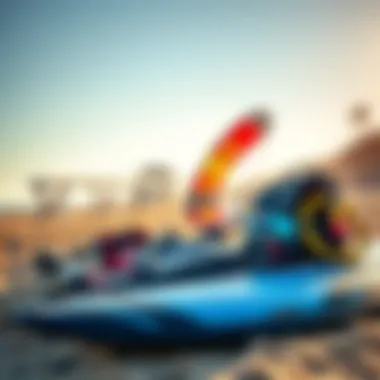
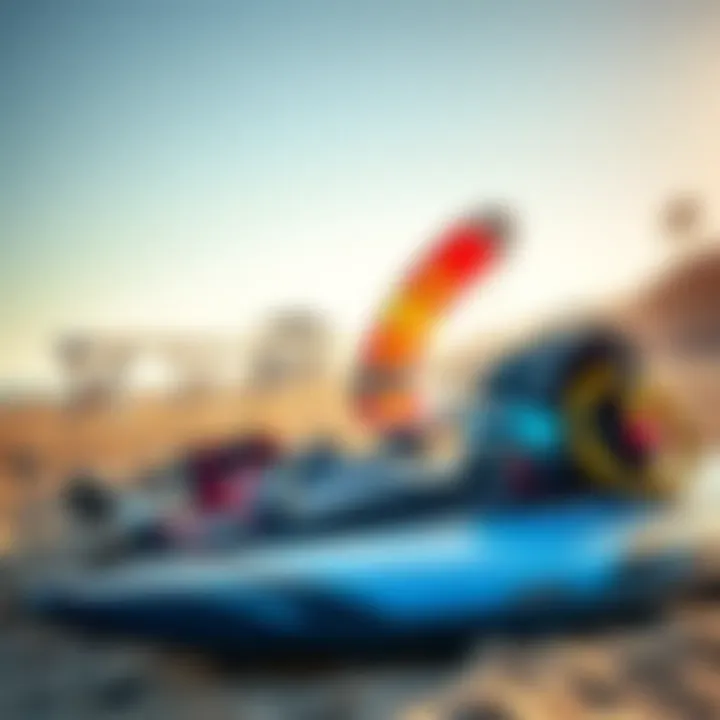
- Kite Size: Your kite's size plays a fundamental role in how it interacts with the wind. Larger kites generate more power but can become unwieldy in strong winds. Conversely, smaller kites maintain better control in high winds. Assess the day’s conditions and choose the kite size accordingly.
- Line Length: Shorter lines can offer better control and quicker response times in gusty conditions. However, longer lines can maximize lift and potential power in lighter winds. Adjusting line lengths ensures you’re in sync with the wind’s behavior throughout your session.
- Bar Pressure: Variations in bar pressure can help kiteboarders gauge wind strength. A firmer pressure typically indicates strong winds and vice-versa. Adjust your settings to ensure comfort while staying connected to your kite’s response in the air.
- Bridle Settings: Some kites allow adjustment of bridle settings to modify performance. Tighter settings can assist with stability in turbulence, while looser settings can enhance performance in light winds.
By investing time in tuning your equipment, you’ll not only boost your riding experience, but also ensure that your gear meets the challenge of San Diego’s often fickle winds.
Adjustments During Varying Conditions
When the wind shifts unexpectedly, it can leave kiteboarders scrambling to adapt. Making swift, judicious adjustments is a vital skill that could be the difference between a smooth ride and an unexpected dunk into the water. Here’s how to navigate those variable conditions:
- Observe Environmental Changes: Nature is full of surprises. Tall buildings and cliffs can create wind shadows, while open areas will showcase stronger winds. Pay attention to how the terrain affects the streams of air.
- Stay Flexible: Adapt your riding style. In lighter winds, a smoother, more dynamic approach can help capture more lift, while in stronger winds, a more aggressive stance will be necessary to maintain control. Experience plays a big role here; the more you ride, the more adept you'll become at reading conditions.
- Adjust Body Positioning: Leaning back or forward to adjust the center of gravity can make a notable difference in performance. In stronger-than-expected winds, leaning back more can help prevent being overpowered by the kite’s pull.
- Communicate: If you’re kiteboarding with friends, keeping an open line of communication helps everyone on the water. Let them know if the wind shifts or if you’re planning to change direction.
The essence is in the experience; nothing beats being out there, recognizing the shifts, and adjusting to the rhythm of the breeze.
"Kiteboarding is as much about the wind as it is about the skill of the rider. Understanding the dance of both is key to mastering the sport."
By employing these techniques for managing wind conditions, kiteboarders can enjoy a rewarding experience and ensure their safety. The winds in San Diego deserve the respect and understanding that every adventurous rider can offer. For more information on kiteboarding techniques, you can explore additional resources such as Wikipedia or Britannica.
Future Trends in Wind Forecasting
The landscape of wind forecasting is changing, which is particularly exciting for kiteboarding enthusiasts in San Diego. As technology advances, understanding local wind dynamics become not just simpler, but more precise. Wind impacts every aspect of kiteboarding, from choosing the right gear to planning the ideal time to hit the water. In this section, we’ll explore cutting-edge advancements in weather prediction and their implications for kiteboarders.
Technological Advances in Weather Prediction
With the rapid development of technology, new tools have emerged that enhance our ability to predict wind patterns. Here are some notable advancements:
- High-Resolution Forecast Models: Unlike older models that provided broad, generalized forecasts, modern high-resolution models offer localized predictions. This means kiteboarders can get real-time updates about wind speed and direction that cater specifically to San Diego’s unique geography.
- Mobile Weather Apps: Applications like Windy and Wind Finder allow kiteboarders to check wind conditions right from their smartphones. These apps provide forecasts up to a week in advance, with live updates on wind information. The intuitive interfaces often display variables like gust strength and direction visually, making it simple to understand complex data.
- Remote Sensing Technology: Instruments that use LIDAR (Light Detection and Ranging) technologies measure wind patterns thousands of feet above the surface. This capability aids in understanding how wind behaves at different altitudes, which in turn can affect kiteboarding strategies.
"Advancements in wind forecasting have transformed the way we prepare for kiteboarding. A shift from traditional methods to tech-driven approaches can be a game-changer for safety and performance."
Impact on Kiteboarding Strategies
As these high-tech tools evolve, kiteboarders in San Diego can significantly refine their strategies. Here’s how these advancements impact the kiteboarding community:
- Enhanced Decision Making: With accurate lightning-fast forecasts, riders can decide when to launch their kites, maximizing their time on the water and reducing the risk of getting caught in unfavorable wind conditions.
- Custom Gear Optimization: Understanding wind dynamics enables kiteboarders to select appropriate kites and boards tailored to specific conditions. For instance, a lighter wind might call for larger kites, while stronger winds could necessitate a smaller setup.
- Safety and Preparedness: By having real-time data, kiteboarders can better gauge the safety of their environment. They can easily assess whether conditions are within their skill set and how to respond to quickly changing weather situations.
- Collective Knowledge Building: Riders can share observations and data on platforms like Reddit or dedicated kiteboarding forums, creating a richer community resource. Each individual report aids in crafting a clearer understanding of unique local wind patterns.
Overall, the integration of forecasting technologies presents exciting horizons for kiteboarders in San Diego, enabling safer, more strategic approaches to the sport. As these advancements continue to improve, the kiteboarding community stands to benefit tremendously.
Concluding Thoughts on Wind and Kiteboarding
As we wrap up this exploration of wind dynamics and their impact on kiteboarding in San Diego, it’s clear that wind is not just a fleeting moment on the water. It is an ongoing conversation between nature and the kiteboarder, shaping every ride, trick, and experience. Understanding wind patterns enables kiteboarders to optimize their performance, stay safe, and relish each thrill the sport has to offer.
The Ongoing Influence of Wind
The variability of wind in San Diego doesn’t just determine if the day is good for kiteboarding; it defines the very essence of the sport. Kiteboarders learn to read the wind like a musician reads sheet music. For instance, during the summer months, the northwest winds blow steadily in the afternoons, providing a dependable playground for enthusiasts. This consistent pattern is what makes spots like Mission Bay and La Jolla so appealing.
The unique geography of San Diego, from hills to open ocean, creates microclimates that can transform how wind behaves in different areas. So, whether you’re hitting the waves by Fiesta Island or enjoying the gusts near Silver Strand, every location has its own flavor of wind. If one can get familiar with how these fluctuations play out, the entire kiteboarding experience is heightened.
However, the same wind that lifts you high can also humble you. Understanding its nuances means knowing when it’s too windy to ride safely or spotting sudden shifts in weather. As kiteboarders, staying alert and reading these signs becomes part of the craft and the joy.
"Wind isn’t just a guideline; it’s a teacher that offers lessons on every swell and gust."
Encouragement for Safety and Adventure
Engaging with the wind creates not just thrilling adventures but carries inherent responsibilities. The exhilaration of flying across the water, performing jumps, and mastering your skills can quickly turn if safety measures aren’t prioritized. Factors like wind strength and direction can change within moments, so being prepared for every scenario is crucial.
New and seasoned riders alike should adopt the following safety tips:
- Check the forecast: Always start with a reliable weather forecast, looking out for changing conditions, especially in coastal areas.
- Use proper equipment: Ensure that your gear suits the wind conditions, adjusting sizes and types of kites as needed.
- Communicate with others: Team up with fellow kiteboarders. Establish signals and watch out for each other while on the water.
- Know your limits: Sometimes, the thrill of the wind can skew judgment. Recognizing when you're pushing too far can prevent accidents.
- Understand local rules: Each kiteboarding spot has its own regulations. Familiarize yourself with any guidelines to ensure everyone’s safety and comfort.
Ultimately, kiteboarding in San Diego is a rich blend of excitement and caution. It’s about harnessing the wind to find that sweet spot of adventure while keeping a keen eye on safety. As kiteboarders, embracing this delicate balance allows us to challenge our limits while respecting the majestic elements at play.
By considering the ongoing influence of wind and remaining vigilant about safety, we enhance not only our experiences but also the kiteboarding community as a whole. With thoughtful preparation and respect for the wind, each session can become a cherished memory on the water.



